The values of psychometric traits are weights ranging from -1 to +1 ( basic psychometric traits ) while the values of the aggregate psychometric traits ( which are equivalent to ready-made correlation matrices ) are values ranging from 0 to 1.
These values are returned both directly on the platform but also in the output of the API calls.
{
"profile": {
"behav_decisionmaking": 0.001,
"behav_impressionmanagement": 0.001,
"behav_lifesatisfaction": 0.001,
"behav_spendingattitude": 0.001,
"net_transitivity": 0.001,
"pers_adventurous": 0.001,
"pers_agreeableness": 0.001,
"pers_altruism": 0.001,
"pers_anger": 0.001,
"pers_anxiety": 0.001,
"pers_art_interests": 0.001,
"pers_assertiveness": 0.001,
"pers_caution": 0.001,
"pers_cheerfulness": 0.001,
"pers_conscientiousness": 0.001,
"pers_cooperativity": 0.001,
"pers_creativity": 0.001,
"pers_depression": 0.001,
"pers_discipline": 0.001,
"pers_efficacy": 0.001,
"pers_emotion": 0.001,
"pers_excitability": 0.001,
"pers_extroversion": 0.001,
"pers_friendlyness": 0.001,
"pers_gregariousness": 0.001,
"pers_immoderability": 0.001,
"pers_intellectual": 0.001,
"pers_liberal": 0.001,
"pers_modesty": 0.001,
"pers_morality": 0.001,
"pers_neuroticism": 0.001,
"pers_openness": 0.001,
"pers_order": 0.001,
"pers_proactivity": 0.001,
"pers_selfcontrol": 0.001,
"pers_sense_of_duty": 0.001,
"pers_simpathy": 0.001,
"pers_trust": 0.001,
"pers_vulnerability": 0.001,
"pers_will": 0.001,
"values_achievement": 0.001,
"values_benevolence": 0.001,
"values_conformity": 0.001,
"values_hedonism": 0.001,
"values_power": 0.001,
"values_security": 0.001,
"values_self-direction": 0.001,
"values_stimulation": 0.001,
"values_tradition": 0.001,
"values_universalism": 0.001
},
"aggregated_profile": {
"Adv-LikesAlternativeCommunication": 0.5,
"Adv-LikesLogicalCommunication": 0.5,
"Adv-LikesTraditionalCommunication": 0.5,
"Adv-LikesUpbeatCommunication": 0.5,
"Attitude-Attractiveness": 0.5,
"Attitude-Churn": 0.5,
"Attitude-Dominance": 0.5,
"Attitude-LoyalCustomer": 0.5,
"Attitude-OpenToInnovation": 0.5,
"Attitude-Passivity": 0.5,
"Attitude-Prosocial": 0.5,
"Attitude-Radicalization": 0.5,
"Attitude-SelfTrascendence": 0.5,
"Attitude-SensationSeeker": 0.5,
"Attitude-ShareEmotionalPosts": 0.5,
"Cognition-HighAttention": 0.5,
"Cognition-Plasticity": 0.5,
"Cognition-Stability": 0.5,
"Credit-RepayDebt": 0.5,
"Insurance-Coverage": 0.5,
"Job-CareerSeeking": 0.5,
"Job-DecisionMaking": 0.5,
"Job-EffectiveLearnigStyle": 0.5,
"Job-GroupTaskProficiency": 0.5,
"Job-IndividualTaskProficiency": 0.5,
"Job-NotManagingStress": 0.5,
"Job-RelationalAbility": 0.5,
"Purchase-Compulsivebuyer": 0.5,
"Purchase-HighSpending": 0.5,
"Purchase-Impulsivebuyer": 0.5,
"PurchaseMotivation-SeekBelonging": 0.5,
"PurchaseMotivation-SeekSelfEnhance": 0.5,
"PurchaseMotivation-SeekStatusDisplay": 0.5,
"Relationship-Anxiety": 0.5,
"Relationship-Avoidance": 0.5,
"Relationship-Quality": 0.5,
"Wellbeing-HealthyStyle": 0.5,
"Wellbeing-LifeSatisfaction": 0.5
},
"traffic_lights": [
{
"correlation_matrix_id": "uuid",
"name": "traffic_lights",
"switched_on": true
}
],
"goal_response": "risposta dell'LLM",
"remaining_credits": 0
}Basic traits
In basic traits, you can find the value of each trait by hovering over the question mark icon, as shown in the figure:
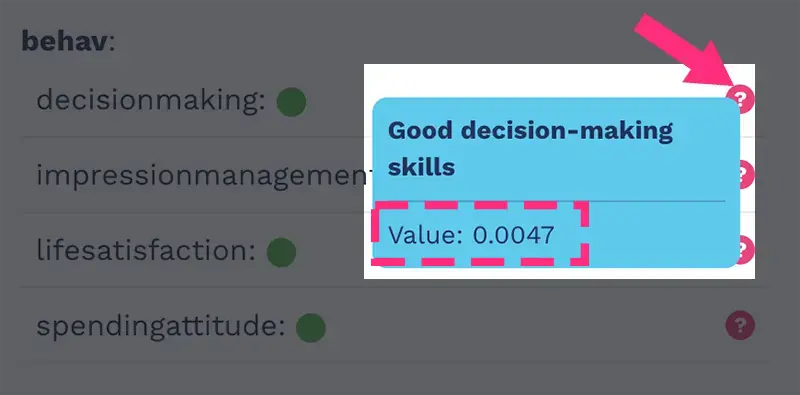
Aggregate traits
In aggregate traits, you can locate the value of each trait by hovering over the question mark icon, as shown in the figure:
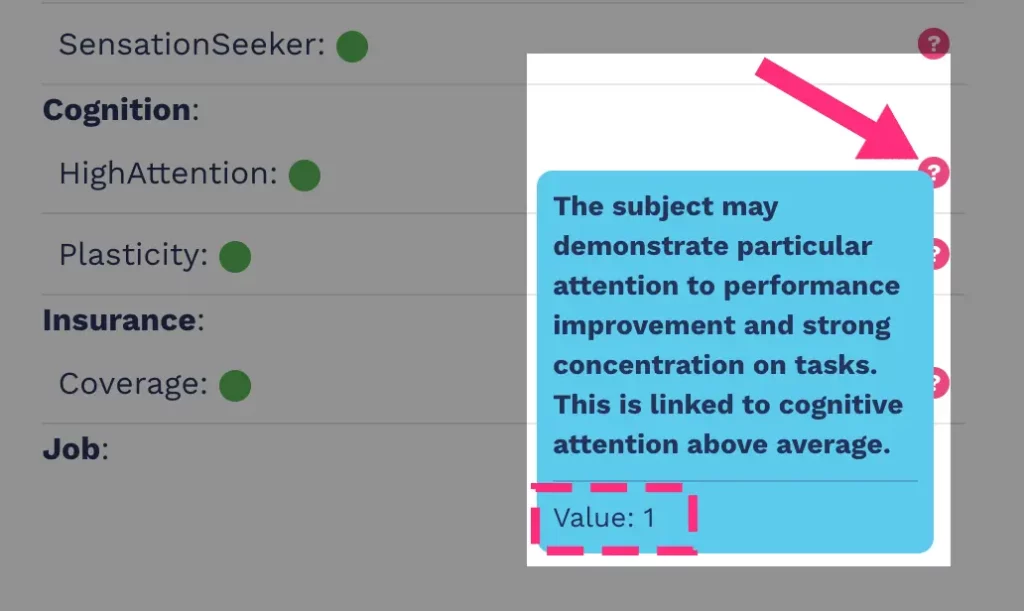
visual reporting of psychometric trait values
The psychometric traits present in a subject will be marked with a green dot, both in the case of basic traits and in the case of aggregate ones, as shown in the figure:
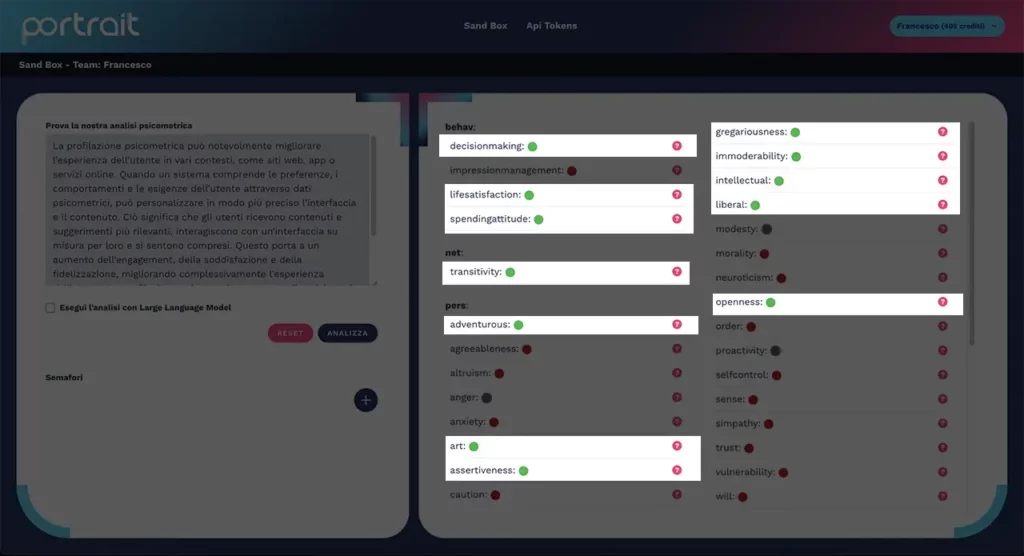
The psychometric traits absent in a subject will be marked with a red dot, both in the case of basic traits and in the case of aggregate ones, as shown in the figure:
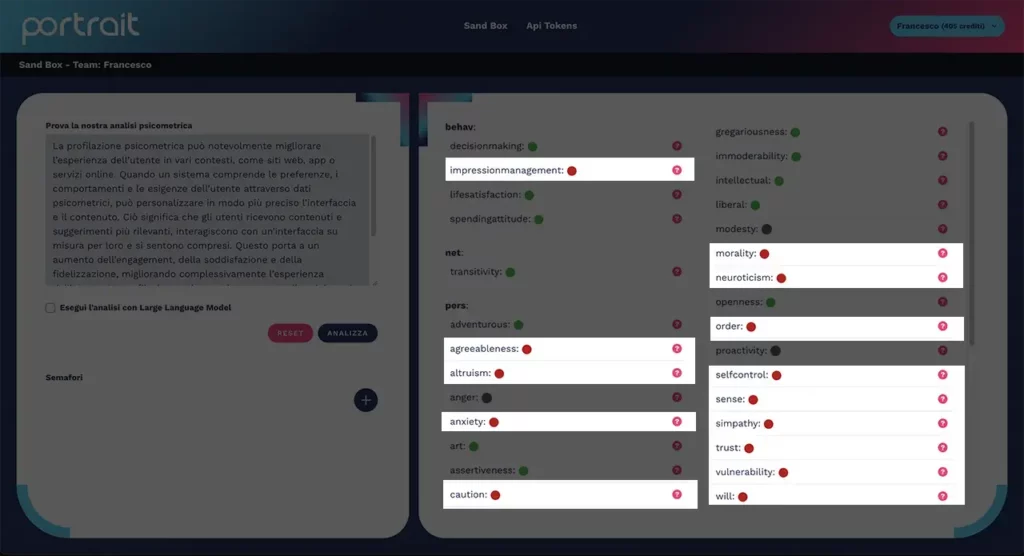
Neutral psychometric traits in a subject will be marked with a grey dot, both in the case of basic traits and in the case of aggregate ones, as shown in the figure:
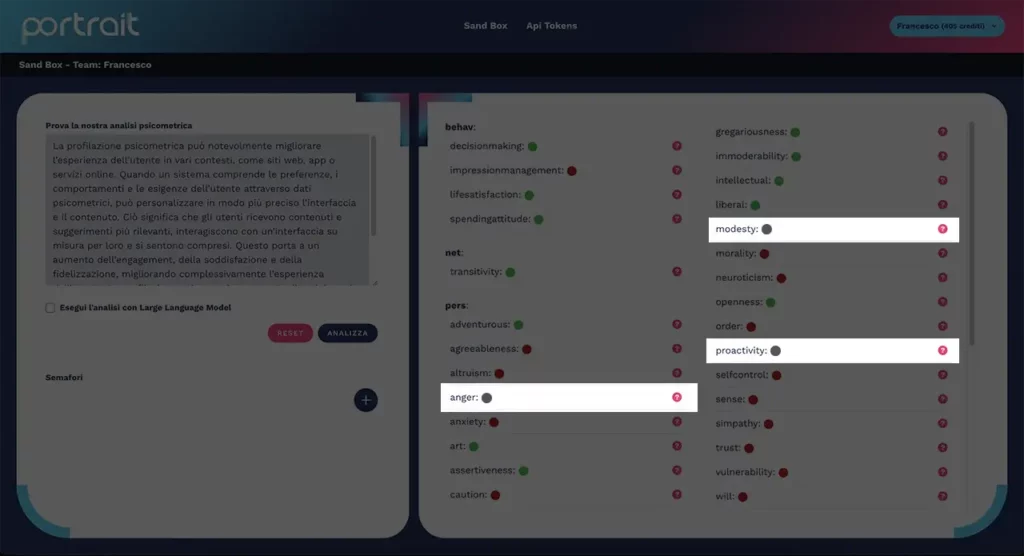
how to use the values of the psychometric traits returned by portrait
To learn how to use the values derived from Portrait’s psychometric analysis, consult the chapter on correlation matrices, which explains how to use such data in the platform.
If you want to understand how traits may be useful to your business, explore the chapters on basic and aggregate psychometric traits. You will be able to discover the meaning of all the traits detected by Portrait and how they can influence your business.
If, however, you want to integrate your systems with psychometric trait values via API calls, check the dedicated section in the documentation for detailed instructions on use.
